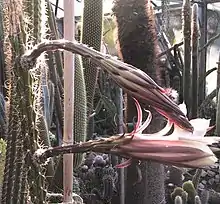| Harrisia taetra | |
|---|---|
 | |
| Scientific classification | |
| Kingdom: | Plantae |
| Clade: | Tracheophytes |
| Clade: | Angiosperms |
| Clade: | Eudicots |
| Order: | Caryophyllales |
| Family: | Cactaceae |
| Subfamily: | Cactoideae |
| Genus: | Harrisia |
| Species: | H. taetra |
| Binomial name | |
| Harrisia taetra Areces | |
Harrisia taetra is a species of cactus found in Cuba.
Description
Harrisia taetra grows like a shrub and reaches heights of 1 to 2.5 meters. The somewhat articulated, cylindrical shoots have a diameter of 6.5 to 8 centimeters and are 0.3 to 1 meter long. There are eight to ten ribs. The stiff, needle-like, straight thorns, initially almost black, later turn whitish yellow. The two to three central spines are 4 to 9 centimeters long. The six to nine marginal spines are 0.7 to 4.4 centimeters long.
The flowers reach a length of 16.5 to 20 centimeters and a diameter of 12 to 15 centimeters. The light to golden yellow, broadly ovoid to somewhat spherical fruits are smooth and covered with a few tiny scales. They have a diameter of 3.8 to 7.2 centimeters and reach a length of 3.5 to 7.3 centimeters.[1]
Distribution
Harrisia taetra is widespread in Cuba in the Pinar del Río province on the Guanahacabibes Peninsula.
Taxonomy
The first description was made in 1981 by L. Alberto E. Areces-Mallea. The specific epithet taetra means 'hideous, hideous, ugly, repulsive'.
References
External links
 Media related to Harrisia taetra at Wikimedia Commons
Media related to Harrisia taetra at Wikimedia Commons Data related to Harrisia taetra at Wikispecies
Data related to Harrisia taetra at Wikispecies